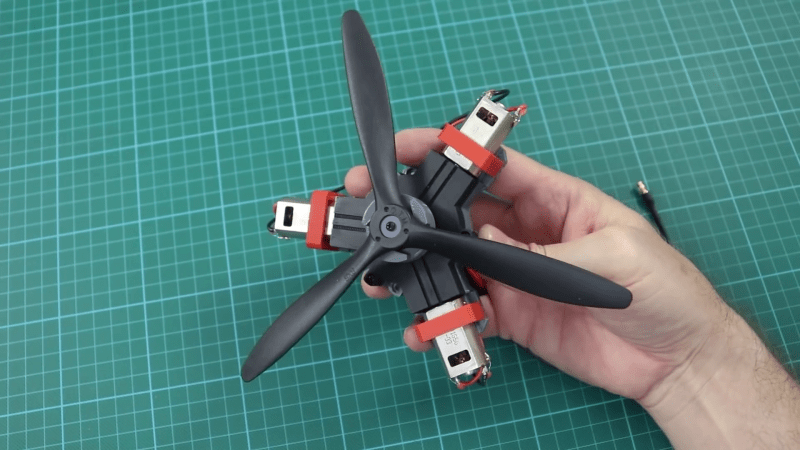For a long time radial aircraft engines, with their distinctive cylinder housings arranged in a circle, were a common sight on aircraft. As an experiment, [KendinYap], wanted to see if he could combine 3 small DC motors into a usable RC aircraft motor, effectively creating an electric radial engine.
The assembly consists of three “180” type brushed DC motors, mounted radially in a 3D printed casing. A 3D printed conical gear is attached to each motor shaft, which drives a single output gear and shaft mounted in the center with two bearings. The gear ratio is 3:1. A variety of propellers can be mounted using 3D printed adaptors. As a baseline, [KendinYap] tested a single motor on a scale with a 4.25-inch propeller on a scale, which produced 170 g of thrust at 21500 RPM. Once integrated into the engine housing, the three motors produced 490 g of thrust at 5700 RPM, with a larger propeller. Three independent motors and propellers should theoretically provide 510 g of thrust, so there are some mechanical losses when combining 3 of them in a single assembly. However, it should still be capable of powering a small RC plane. It’s also not impossible that a different propeller could yield better results.
While there is no doubt that it’s no match for a brushless RC motor, testing random ideas just to see if it’s possible is usually fun and an excellent learning experience. We’ve seen some crazy flyable RC power plants, including a cordless drill, a squirrel-cage blower, and a leaf blower.
















Call it triple redundant and sell it to the military. They’ll turn it into a standard.
Interesting to notice that several types of plastic have been used.
I wonder that if the main gear can be made conical too, so the motors can be aligned with the propeller axis, instead of perpendicular.
Then it wouldn’t look like a radial engine, would it ;-)
I imagine that a layout similar to a duke engine could be done to conserve some space
I had never heard of one, so I DAGS
http://www.dukeengines.com/
I didn’t see any mention of a cooling system.
If motors were coaxial with propeller axis, you could use simple spur gears. Then maybe you could reduce some inefficiencies and use single bigger motor ;).
Add another bevel gear on top and coaxial shafts, and you’ll get contra-rotating propellers easily. Improved aerodynamical efficiency and less torque permits lighter structure.
Excellent work. Do the solenoids have parallel diodes in them?
Don’t expect a reply. Its just someone who has something to say about everything. Wonder what kind of radial motors he has designed. Leave it to the arm-chair pro’s. Nothing constructive to say.
In the end 3 of the single motored 4.25×6 blade seems to have more thrust than the 3 motor gear with 10×6 prop. With all the additional material, friction, etc, is it really worth it? We didn’t see power draw, so no word on efficiency. Anyway cool concept, just seems like a solution looking for a problem.
I doubt it can win on any practical front until you really start pushing with really high power tiny motors that will need better cooling than being inline/direct drive can really provide.
But damn does it look cool, and with a little refinement probably a nice motor to put in your RC piston engine warbird – it looks the part, and works.
Did he subtract the initial weight from his end results? Didn’t look like it… I wonder how variable pitch blades will perform.
the sound is superb. i want one please…
Now THAT’S an electric radial. Can’t wait for the 7 and the 9 then on to the multi-row. Be sure to recycle the back EMF spike rather than burn it off in a suppression diode.
I want to see the 16 “cylinder” model with pager/vibration motors
But remove the off-balance weights first!
B^)
Back in 2007 while in Okinawa I saw a guy with this set up using what looked like3 large drill motors. Spinning a homemade 24 inch prop on his R/C airplane.
My concern would be melting gears if 3d printed. If machined etc from metal then the sound might dissappear. Perhaps just use a big brushless…or a saito radial after all.
This isn’t really how a radial engine works. I would have been impressed if you had accomplished this with a crank case surrounded by electric solenoids to act as cylinders.
Search youtube for “solenoid radial motor” and you’ll find many of these!
How does this thrust measurement work? Curious people want to know. Isn’t the a bit of the old push-me pull-you going on? I suspect measurements are way too low?
how did he attach the motors to the scale? I would be so nervous LOL. I had a motor with only a 5 inch prop get free, and it was pretty intense haha
Go spiral / helical to reduce noise
Example:
https://ae01.alicdn.com/kf/HTB1daVLiC8YBeNkSnb4q6yevFXas/Aiyima-1-pair-1-Modulus-1-3-Small-Spiral-Bevel-Gear-Carbon-Steel-Helical-Gear-Electrical.jpg